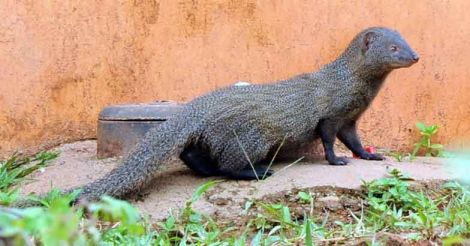We feel comfortable when a mongoose roams around the courtyard because the shy creature is a sworn enemy our best enemy, snake. The mongoose definitely don’t share the feeling though.
The thick hairy coat that helps the carnivorous mammal from snake attacks now turn life-threatening for them. The creatures are hunted down in large numbers for their hair that makes enduring bristles for paint brushes. Most often their hairs are plucked when they are still alive.
Many art schools in the country have woken up to the cruelty that goes into the pursuit of art. They make it a point that they buy brush with synthetic bristles. Many individual artists, however, are not very aware of the problem. Environmental activists have teamed up with artists to create awareness about the practice that threatens the species.
Kerala principal chief conservator of forests G Harikumar told Onmanorama that the Forest Department was aware of the mongoose hunt for manufacturing brushes for painting and makeup. More than 14,000 brushes made of mongoose hair had been seized from Kochi last year.
The Forest Department has been deliberately trying to keep this surge in demand low-profile to spare the mongooses the plight of the barn owls and the red sand boas, which has been targeted by fortune seekers for their perceived magical powers.
The department focuses on creating awareness among the public that hunting mongooses and other protected species like ant-eaters is a crime that attracts penalty under the Wildlife (Protection) Act. Even the police and the Vigilance and Anti-Corruption Bureau are roped in in the fight against poachers.
Protected species
All the six types of mongooses found in India belong to the protected category under the Wildlife (Protection) Act, 1972. Killing them or plucking their hair attract a jail term of three to seven years and a fine of Rs 10,000. Mongooses had bee protected under Schedule 4 of the Act since 1991. They were later moved to Schedule 2 when it came to be known that an organised mafia was behind the mongoose hunt across India. This heightened scrutiny was ensured partly with the help of a documentary by Saeed Fayaz. A Brush With Death - The Story Behind the Mongoose Hair Brushes was instrumental in putting the spotlight on the cruel practice.
Mongoose is also classified under the Red List as an endangered species. Any trade of the mongoose or any part of it is banned under the Convention of International Trade in Endangered Species of Wild Flora and Fauna, which is also signed by India.
‘Zero Tolerance’
The theme for the World Environment Day 2016 is ‘Go Wild for Life - Zero Tolerance for the Illegal Wildlife Trade.’ When big game such as elephants and tigers coming under increased protection, poachers turn to easy prey such as mongooses and ant-eaters. Kerala is one of the eight states where mongooses are hunted down in hordes, according to the Wildlife Trust of India. Small Indian mongooses, striped-necked mongooses and Indian gray mongooses are particularly in demand in the illegal brush-making industry. These species are common in Kerala.
The sale of mongoose hair brushes are rampant in Kerala despite an international ban on the trade, a recent survey had found out.
The Wildlife Crime Control Bureau is actively tracking for any signs of wildlife smuggling.
If you suspect any mongoose hunt is going on in your locality, inform the nearest police station or the Forest Department office. You can call up the Forest Department’s toll free number, 1800 425 4733.
Untold cruelty

We cannot even imagine the pain of plucking a hair from our forehand. Mongooses go through pain many times greater than that at the hands of the poachers. They do not wait for the mongooses to die before de-hairing them. The hapless creatures are then left to die.
Some of the hunters pluck only the long hair, leaving mongooses to survive with an ugly patch. Many such mongooses are reported from across the state. Many people just shoo them away thinking they are diseased. Any such sightings indicate that hunters are active in the area. This calls for immediate reporting to the police or the forest officers.
Mongooses do not live longer without their precious coat.
Art that kills

Did you know that your favourite paint brush with black-white-gray-brown hair actually belonged to mongoose?
Brushes made of synthetic bristles are as good as mongoose hair brushes, but the illegal trade thrives on people who go behind the fad.
Though no mongoose census was undertaken in India, the Wildlife Trust of India estimates that more than 50,000 mongooses are killed in India a year. The hair collected from Kerala, Uttarkhand, Uttar Pradesh, Madhya Pradesh, Karnataka, Tamil Nadu, Chhattisgarh and Maharashtra are turned into brushes in the illegal factories of Ghaziabad, Kanpur, Meerut, Nashik, Chennai, Mumbai, Delhi and Siliguri. West Bengal still has communities who have made mongoose hunt their livelihood for ages.
These brushes are smuggled out of the country through Nepal and Bhutan.
About 30,000 mongoose hair brushes were seized from Delhi after the law was tightened in 2009. Aout 20,000 brushes were seized from Kolkata in 2013.
Deadly harvest
An adult mongoose will only have 40 grams of hair on average. About 50 mongooses will have to be killed for a kilo of hair.
Mongooses become active during the harvest season in April and May. Hunters have a busy time too. Mongooses do a great service to the farmers by eating the mice, rats, frogs, snakes and other insects and keeping a check on their population. The massacre of the mongooses are a guaranteed way to disturb the fragile food chain. But the hunters and the illegal brush makers would have none of it.
























